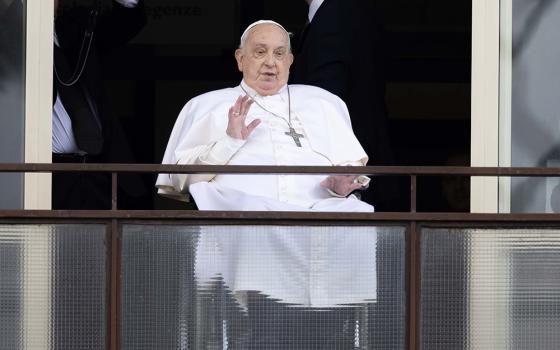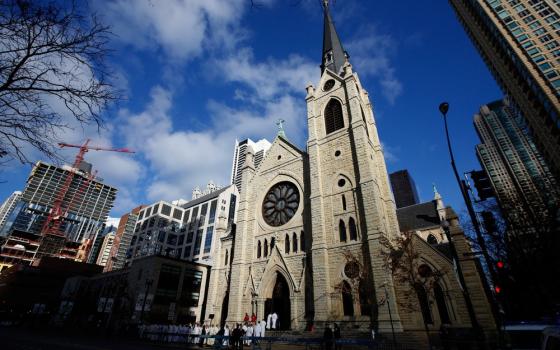There’s always room for one more needy soul seeking shelter at a Catholic Worker house.
The same was true when three folks fleeing from a major fire in northern California last month showed up at the Sonora home of Chris and Joan Montesano with five critters in tow -- two guinea pigs, two cats and one parrot. The retired couple didn’t bat an eye.
As veteran Catholic Workers, the Montesanos had long ago learned the grace of flexibility. They worked with Dorothy Day, co-founder of the Catholic Worker movement, in 1968 at her New York headquarters. Eight years later, foreseeing a looming environmental crisis, they moved away from Martin dePorres Catholic Worker House in San Francisco to open the Earth Abides Farm in Sheep Ranch, Calif., in the foothills of the Sierra Nevada Mountain Range.
The farm founding was in response to co-founder Peter Maurin’s vision of a “green revolution.” As far back as 1933, Maurin had imagined Catholic Worker farms that rather than tout industrialism and synthetic fertilizers, sought to mimic the practices of medieval Irish monks who during the Dark Ages sought to reconstruct society in part through houses of hospitality that offered homegrown food, prayer and shelter to wayfarers.
In this tradition, Earth Abides Farm is one of the more than a dozen farms among the 208 Catholic Worker communities across the United States. The 80-acre land trust maintains a quarter-acre organic farm and sponsors monthly retreats for people with AIDS and other terminal illnesses and their caretakers.
Fire led the farm to safeguard some of its own.
Tom Spiritbringer, Marcus Collonge and his wife, Chelsea -- all members of the Catholic Worker movement -- had been forced to evacuate themselves and their 13 farm animals from their homes on Sept. 11, two days after the Butte Fire in began burning its way though Amador and Calaveras Counties along the Sierra Nevada. The “epic” fire, as Spiritbringer described it, would claim two lives, destroy 818 structures (including 475 homes), and ravaged 70,868 acres before it was fully contained on Oct. 1.
Flames came within four miles the farm.
Spiritbringer likened their evacuation to a modern-day version of Noah’s Ark.
“By noon we had our two Alpacas, Redman and Leander, in the back of the van along with our two guinea pigs, K & T, and our two cats, Noir and Hatchet. Granny Blue, our Mercedes that runs on veggie oil, was carrying our three goats, La Mancha and her two boys, Billy and Bobby, plus our parrot, Turkey,” he wrote in an email.
Their second “boat,” a Toyota truck, carried three more goats -- Snow, Niels-Zug and Richardocito -- to another ranch. Forty miles later, the much-lighter “ark” arrived at the Montesanos’ home for a 12-day stay to wait out the fire. To wait, to pray and to sorrow as the flames destroyed hundreds of homes along its path, disrupting the lives of countless people, including many of their friends.
The time since the final flames extinguished has offered Montesano, Collonge and Spiritbringer to reflect upon the fire, part of one of America’s worst fire seasons. Montesano saw the blaze as fueled by California’s historic drought likely made worse from climate change. He is not alone.
California Gov. Jerry Brown in mid-September drew a line between the fires, drought and climate change, saying rising mean temperatures combined with years of drought “means that the conditions are worse, they’re drier, and therefore these fires are acting more aggressively, more unpredictable.” A month earlier, climate scientists found that global warming “most likely intensified the drought in California by 15 to 20 percent.” Other scientists have looked closely at climate change’s impacts on wildfires and forests.
Montesano added the “poor and vulnerable” that Pope Francis alludes to in his encyclical, “Laudato Si’, on Care for Our Common Home,” include California residents who have lost everything.
Another factor contributing to the flames in Montesano’s mind? “Human error,” he said. A former 19-year volunteer fireman, Montesano said an abundance of underbrush on the forest floor acted as fuel for the conflagration.
“Our forests are full of this decayed matter, this duff,” he said.
When the Native Americans left an area, he explained, they would do “prescribed burns and light the forest behind them,” a practice that helped prevent widespread disasters like northern California has experienced with the Butte Fire and others. Western Civilization has not caught on to the practice as much as it needs to, he said.
Waiting for the Butte Fire’s containment created many nervous moments for Earth Abides’ human residents. Before returning to their home for good, Spiritbringer and Collonge made a test run on Sept. 16 to inspect the premises. Were their chickens okay? Before evacuating, the men had turned them loose, hoping for the best. They braced themselves for the sight of wilted vegetables.
As they drove onto their land, Spiritbringer said, “there was an eerie feeling silence, quietude, emptiness. No animal or human noises. A sudden strong, swirling wind tweaked at us to get out of there.”
And then, lo, some good news.
The freed chickens were safe and some neighbors had already returned home. And thanks to a kind but stubborn neighbor who refused to evacuate, the garden was watered and fine, too, outside a few gophers “helping themselves to five percent more of the lettuce than their usual take,” Collonge said.
While relieved to be home, the Catholic Workers have experienced survivor sadness, combined with a realistic outlook as to what could happen again. Collonge went through the list of environmental hazards always present at Sheep Ranch:
- Drought: “We’ve dug the well deeper for every decade in the four decades since Earth Abides began.”
- Fire: “It’s always a threat forever, there unless climate change tweaks it into bizarre new realities.”
- Earthquakes: “We’re at the edge of the foothills and the beginning of the mountains of the Pacific Rim formed by geological quaking activity and we’re overdue, allegedly, for the big one.”
But the important thing, Collonge said, “is the Catholic Worker farming movement’s impetus to be more like ancestors, tied to the land, in the indigenous sense: We belong to the earth, we are earthlings, the land and the people cannot be separated.”
Spiritbringer was saddened by the plight of those whose lives have been turned upside down, recalling a Hindu sutra: “Tat Tvan Asi,” meaning “I see the other in myself and myself in the other.”
“Even though our buildings and lives were saved, in a deep sense we are One and I cannot feel true joy and I grieve. I am the other person who may need my help,” he said.
Meanwhile, life continued as the Colognes and Spiritbringer prepared for their upcoming monthly retreat, which began Oct. 9, with a group of terminally ill individuals. It was to be fully in the spirit of Peter Maurin, Dorothy Day and St. Francis. Guest activities usually include collecting eggs, feeding the chickens, transplanting veggies, helping with seed saving and spinning alpaca fleece into yarn.
And this time, they will give thanks that this Catholic Worker farm is still an abiding presence in the town of Sheep Ranch.
[Sharon Abercrombie is a frequent contributor to Eco Catholic.]
Editor's note: Want more stories from Eco Catholic? We can send you an email alert once a week with the latest. Just go to this page and follow directions: Email alert sign-up.




